Retrieval of Metop-A/IASI N2O Profiles and Validation with NDACC FTIR Data
Abstract
1. Introduction
2. Global Retrieval of NO Profiles From IASI
2.1. IASI
2.2. IASI-SOFRID NO Retrievals
3. FTIR NO from NDACC Stations
4. Characterization of SOFRID and FTIR NO Retrievals
4.1. Theoretical Characterization of Retrieved Profiles
4.2. Information Content and Error Analysis for Iasi and Ftir NO Retrievals
5. Validation Results
5.1. Methodology
5.2. Results
5.2.1. General Statistics
5.2.2. Long Term Variations
5.2.3. Seasonal Cycles
6. Global Distributions
7. Conclusions
Author Contributions
Funding
Data Availability Statement
Acknowledgments
Conflicts of Interest
Abbreviations
| FTIR | Fourier Transform Infrared |
| GH | Geopotential Height |
| GOSAT | Greenhouse Gases Observing Satellite |
| IASI | Infrared Atmospheric Sounding Interferometer |
| ESRL | Earth System Research Laboratories |
| MT | Middle Troposphere |
| NDACC | Network for the Detection of Atmospheric Composition Change |
| NOAA | National Oceanic and Atmospheric Administration |
| NH | Northern Hemisphere |
| LT | Lower Tropopsphere |
| OEM | Optimal Estimation Method |
| RMSD | Root Mean Square Deviation |
| SCIAMACHY | SCanning Imaging Absorption spectroMeter for Atmospheric CartograpHY |
| SH | Southern Hemisphere |
| SOFRID | Software for the Retrieval of IASI Data |
| UT | Upper Troposphere |
| VMR | Volume Mixing Ratio |
References
- Myhre, G.; Shindell, D.; Breon, F.M.; Collins, W.; Fuglestvedt, J.; Huang, J.; Koch, D.; Lamarque, J.F.; Lee, D.; Mendoza, B.; et al. Anthropogenic and Natural Radiative Forcing. In Climate Change 2013: The Physical Science Basis. Contribution of Working Group I to the Fifth Assessment Report of the Intergovernmental Panel on Climate Change; Cambridge University Press: Cambridge, UK; New York, NY, USA, 2013. [Google Scholar]
- Forster, P.; Ramaswamy, V.; Artaxo, P.; Berntsen, T.; Betts, R.; Fahey, D.; Haywood, J.; Lean, J.; Lowe, D.; Myhre, G.; et al. Changes in Atmospheric Constituents and in Radiative Forcing. In Climate Change 2007: The Physical Science Basis. Contribution of Working Group I to the Fourth Assessment Report of the IPCC; Cambridge University Press: Cambridge, UK; New York, NY, USA, 2008. [Google Scholar]
- Prather, M.J.; Hsu, J.; DeLuca, N.M.; Jackman, C.H.; Oman, L.D.; Douglass, A.R.; Fleming, E.L.; Strahan, S.E.; Steenrod, S.D.; Søvde, O.A.; et al. Measuring and modeling the lifetime of Nitrous Oxide including its variability, the tropopause: Satellite observations and model simulations. J. Geophys. Res. Atmos. 2015, 120, 5693–5705. [Google Scholar] [CrossRef] [PubMed]
- Davidson, E.; Kanter, D. Daily ozone vertical profile model built on geophysical grounds, for column retrieval from atmospheric high-resolution infrared spectra. Environ. Res. Lett. 2014, 9, 105012. [Google Scholar] [CrossRef]
- Butterbach-Bahl, K.; Baggs, E.M.; Dannenmann, M.; Kiese, R.; Zechmeister-Boltenstern, S. Nitrous Oxide emissions from soils: How well do we understand the processes and their controls? Phil. Trans. R. Soc. B 2013, 368, 20130122. [Google Scholar] [CrossRef]
- Davidson, E.; Kanter, D. The contribution of manure and fertilizer nitrogen to atmospheric Nitrous Oxide since 1860. Nat. Geosci. 2009, 2, 659–662. [Google Scholar] [CrossRef]
- Tian, H.; Chen, G.; Lu, C.; Xu, X.; Ren, W.; Zhang, B.; Banger, K.; Tao, B.; Pan, S.; Liu, M.; et al. Global methane and Nitrous Oxide emissions from terrestrial ecosystems due to multiple environmental changes. Ecosyst. Health Sustain. 2015, 1, 4. [Google Scholar] [CrossRef]
- Tian, H.; Xu, R.; Canadell, J.E.A. A comprehensive quantification of global Nitrous Oxide sources and sinks. Nature 2020, 586, 248–256. [Google Scholar] [CrossRef]
- Ciais, P.; Sabine, C.; Bala, G.; Bopp, L.; Brovkin, V.; Canadell, J.; Chhabra, A.; DeFries, R.; Galloway, J.; Heimann, M.; et al. Carbon and Other Biogeochemical Cycles. In Climate Change 2013: The Physical Science Basis. Contribution of Working Group I to the Fifth Assessment Report of the Intergovernmental Panel on Climate Change; Cambridge University Press: Cambridge, UK; New York, NY, USA, 2013. [Google Scholar]
- Wells, K.C.; Millet, D.B.; Bousserez, N.; Henze, D.K.; Griffis, T.J.; Chaliyakunnel, S.; Dlugokencky, E.J.; Saikawa, E.; Xiang, G.; Prinn, R.G.; et al. Top-down constraints on global N2O emissions at optimal resolution: Application of a new dimension reduction technique. Atmos. Chem. Phys. 2018, 18, 735–756. [Google Scholar] [CrossRef]
- Haszpra, L.; Barcza, Z.; Hidy, D.; Szilagyi, I.; Dlugokencky, E.; Tans, R. Trends and temporal variations of major greenhouse gases at a rural site in Central Europe. Atmos. Environ. 2008, 42, 8707–8716. [Google Scholar] [CrossRef]
- Angelbratt, J.; Mellqvist, J.; Blumenstock, T.; Borsdorff, T.; Brohede, S.; Duchatelet, P.; Forster, F.; Hase, F.; Mahieu, E.; Murtagh, D.; et al. A new method to detect long term trends of methane (CH4) and nitrous oxide (N2O) total columns measured within the NDACC ground-based high resolution solar FTIR network. Atmos. Chem. Phys. 2011, 63, 6167–6183. [Google Scholar] [CrossRef]
- Bergamaschi, P.; Frankenberg, C.; Meirink, J.; Krol, M.; Villani, M.; Houweling, S.; Dentener, F.; Dlugokencky, E.; Miller, J.; Gatti, L.; et al. Inverse modeling of global and regional CH4 emissions using SCIAMACHY satellite retrievals. J. Geophys. Res. Atmos. 2007, 114. [Google Scholar] [CrossRef]
- Turner, A.; Jacob, D.; Wecht, K.; Maasakkers, J.; Lundgren, E.; Andrews, A.; Biraud, S.; Boesch, H.; Bowman, K.; Deutscher, N.; et al. Estimating global and North American methane emissions with high spatial resolution using GOSAT satellite data. Atmos. Chem. Phys. 2015, 15, 7049–7069. [Google Scholar] [CrossRef]
- Bergamaschi, P.; Corazza, M.; Karstens, U.; Athanassiadou, M.; Thompson, R.L.; Pison, I.; Manning, A.J.; Bousquet, P.; Segers, A.; Vermeulen, A.T.; et al. Top-down estimates of European CH4 and N2O emissions based on four different inverse models. Atmos. Chem. Phys. 2015, 15, 715–736. [Google Scholar] [CrossRef]
- Chedin, A.; Hollingsworth, A.; Scott, N.A.; Serrar, S.; Crevoisier, C.; Armante, R. Annual and seasonal variations of atmospheric CO2, N2O and CO concentrations retrieved from NOAA/TOVS satellite observations. Geophys. Res. Lett. 2002, 29, 110-1–110-4. [Google Scholar] [CrossRef]
- Ricaud, P.; Attie, J.L.; Teyssedre, H.; Amraoui, V.L.; Peuch, V.H.; Matricardi, M.; Schluessel, P. Equatorial total column of Nitrous Oxide as measured by IASI on MetOp-A: Implications for transport processes. Atmos. Chem. Phys. 2009, 9, 3947–3956. [Google Scholar] [CrossRef]
- García, O.E.; Sepúlveda, E.; Schneider, M.; Hase, F.; August, T.; Blumenstock, T.; Kühl, S.; Munro, R.; Gómez-Peláez, Á.J.; Hultberg, T.; et al. Consistency and quality assessment of the Metop-A/IASI and Metop-B/IASI operational trace gas products (O3, CO, N2O, CH4, and CO2) in the subtropical North Atlantic. Atmos. Meas. Tech. 2016, 9, 2315–2333. [Google Scholar] [CrossRef]
- August, T.; Klaes, D.; Schlüssel, P.; Hultberg, T.; Crapeau, M.; Arriaga, A.; O’Carroll, A.; Coppens, D.; Munro, R.; Calbet, X. IASI on Metop-A: Operational Level 2 retrievals after five years in orbit. J. Quant. Spectrosc. Radiat. Transf. 2012, 113, 1340–1371. [Google Scholar] [CrossRef]
- García, O.E.; Schneider, M.; Ertl, B.; Sepúlveda, E.; Borger, C.; Diekmann, C.; Wiegele, A.; Hase, F.; Barthlott, S.; Blumenstock, T.; et al. The MUSICA IASI CH4 and N2O products and their comparison to HIPPO, GAW and NDACC FTIR references. Atmos. Meas. Tech. 2018, 11, 4171–4215. [Google Scholar] [CrossRef]
- Wofsy, S. HIAPER Pole-to-Pole Observations (HIPPO): Fine-grained, global-scale measurements of climatically important atmospheric gases and aerosols. Phil. Trans. R. Soc. A 2011, 369. [Google Scholar] [CrossRef]
- De Wachter, E.; Barret, B.; Le Flochmoen, E.; Pavelin, E.; Matricardi, M.; Clerbaux, C.; Hadji-Lazaro, J.; George, M.; Hurtmans, D.; Coheur, P.F.; et al. Retrieval of MetOp-A/IASI CO profiles and validation with MOZAIC data. Atmos. Meas. Tech. 2012, 5, 2843–2857. [Google Scholar] [CrossRef]
- Barret, B.; Le Flochmoen, E.; Sauvage, B.; Pavelin, E.; Matricardi, M.; Cammas, J.P. The detection of post-monsoon tropospheric ozone variability over south Asia using IASI data. Atmos. Chem. Phys. 2011, 11, 9533–9548. [Google Scholar] [CrossRef]
- Van Damme, M.; Erisman, J.W.; Clarisse, L.; Dammers, E.; Whitburn, S.; Clerbaux, C.; Dolman, A.J.; Coheur, P.F. Worldwide spatiotemporal atmospheric ammonia (NH3) columns variability revealed by satellite. Geophys. Res. Lett. 2015, 42, 8660–8668. [Google Scholar] [CrossRef]
- Saunders, R.; Matricardi, M.; Brunel, P. An improved fast radiative transfer model for assimilation of satellite radiance observations. Q. J. R. Meteorol. Soc. 1999, 125, 1407–1425. [Google Scholar] [CrossRef]
- Pavelin, E.; English, S.; Eyre, J. The assimilation of cloud-affected infrared satellite radiances for numerical weather prediction. Q. J. R. Meteorol. Soc. 2008, 134, 737–749. [Google Scholar] [CrossRef]
- Matricardi, M.; Chevallier, F.; Kelly, G.; Thepaut, J.N. An improved general fast radiative transfer model for the assimilation of radiance observations. Q. J. R. Meteorol. Soc. 2004, 130, 153–173. [Google Scholar] [CrossRef]
- Matricardi, M. Technical Note: An assessment of the accuracy of the RTTOV fast radiative transfer model using IASI data. Atmos. Chem. Phys. 2009, 9, 6899–6913. [Google Scholar] [CrossRef]
- Clough, S.; Shephard, M.; Mlawer, E.; Delamere, J.; Iacono, M.; Cady-Pereira, K.; Boukabara, S.; Brown, P. Atmospheric radiative transfer modeling: A summary of the AER codes. J. Quant. Spectrosc. Radiat. Transf. 2005, 91, 233–244. [Google Scholar] [CrossRef]
- Rothman, L.S.; Jacquemart, D.; Barbe, A.E.A. The HITRAN 2004 molecular spectroscopic database. J. Quant. Spectrosc. Radiat. Transf. 2005, 96, 139–204. [Google Scholar] [CrossRef]
- Borbas, E.; Ruston, B. The RTTOV UWiremis IR land surface emissivity module. In AS Mission Report NWPSAF-MO-VS-042, EUMETSAT Numerical Weather Prediction Satellite Applications Facility; Met Office: Exeter, UK, 2010. [Google Scholar]
- Seemann, S.W.; Borbas, E.E.; Knuteson, R.O.; Stephenson, G.R.; Huang, H.L. Development of a Global Infrared Land Surface Emissivity Database for Application to Clear Sky Sounding Retrievals from Multi-spectral Satellite Radiance Measurements. J. Appl. Meteor. Climatol. 2008, 47, 108–123. [Google Scholar] [CrossRef]
- Rodgers, C.D. Inverse Methods for Atmospheric Sounding: Theory and Practice, Series on Atmospheric, Oceanic and Planetary Physics; World Scientific: Singapore; Hackensack, NJ, USA; London, UK; Hong Kong, China, 2000; Volume 2, p. 238. [Google Scholar]
- Clerbaux, C.; Boynard, A.; Clarisse, L.; George, M.; Hadji-Lazaro, J.; Herbin, H.; Hurtmans, D.; Pommier, M.; Razavi, A.; Turquety, S.; et al. Monitoring of atmospheric composition using the thermal infrared IASI/MetOp sounder. Atmos. Chem. Phys. 2009, 9, 6041–6054. [Google Scholar] [CrossRef]
- Hilton, F.; Armante, R.; August, T.; Barnet, C.; Bouchard, A.; Camy-Peyret, C.; Capelle, V.; Clarisse, L.; Clerbaux, C.; Coheur, P.F.; et al. Hyperspectral earth observation from iasi five years of accomplishments. Bull. Am. Meteorol. Soc. 2012, 93, 347–370. [Google Scholar] [CrossRef]
- Kort, E.A.; Patra, P.K.; Ishijima, K.; Daube, B.C.; Jimenez, R.; Elkins, J.; Hurst, D.; Moore, F.L.; Sweeney, C.; Wofsy, S.C. Tropospheric distribution and variability of N2O: Evidence for strong tropical emissions. Geophys. Res. Lett. 2011, 38. [Google Scholar] [CrossRef]
- Nevison, C.D.; Dlugokencky, E.; Dutton, G.; Elkins, J.W.; Fraser, P.; Hall, B.; Krummel, P.B.; Langenfelds, R.L.; O’Doherty, S.; Prinn, R.G.; et al. Exploring causes of interannual variability in the seasonal cycles of tropospheric Nitrous Oxide. Atmos. Chem. Phys. 2011, 11, 3713–3730. [Google Scholar] [CrossRef]
- Havemann, S. NWPSAF 1D-Var User Manual Software Version 1.2. In AS Mission Report NWPSAF-MO-UD-032, EUMETSAT Numerical Weather Prediction Satellite Applications Facility; Met Office: Exeter, UK, 2020. [Google Scholar]
- Zhou, M.; Langerock, B.; Vigouroux, C.; Sha, M.K.; Hermans, C.; Metzger, J.M.; Chen, H.; Ramonet, M.; Kivi, R.; Heikkinen, P.; et al. TCCON and NDACC XCO measurements: Difference, discussion and application. Atmos. Meas. Tech. 2019, 12, 5979–5995. [Google Scholar] [CrossRef]
- Barret, B.; Turquety, S.; Hurtmans, D.; Clerbaux, C.; Hadji-Lazaro, J.; Bey, I.; Auvray, M.; Coheur, P. Global carbon monoxide vertical distributions from spaceborne high-resolution FTIR nadir measurements. Atmos. Chem. Phys. 2005, 5, 2901–2914. [Google Scholar] [CrossRef]
- Coheur, P.; Barret, B.; Turquety, S.; Hurtmans, D.; Hadji-Lazaro, J.; Clerbaux, C. Retrieval and characterization of ozone vertical profiles from a thermal infrared nadir sounder. J. Geophys. Res. 2005, 110. [Google Scholar] [CrossRef]
- Boynard, A.; Clerbaux, C.; Coheur, P.F.; Hurtmans, D.; Turquety, S.; George, M.; Hadji-Lazaro, J.; Keim, C.; Meyer-Arnek, J. Measurements of total and tropospheric ozone from IASI: Comparison with correlative satellite, ground-based and ozonesonde observations. Atmos. Chem. Phys. 2009, 9, 6255–6271. [Google Scholar] [CrossRef]
- Xiong, X.; Maddy, E.; Barnet, C.; Gambacorta, A.; Patra, P.; Sun, F.; Goldberg, M. Retrieval of Nitrous Oxide from Atmospheric Infrared Sounder: Characterization and validation. J. Geophys. Res. Atmos. 2014, 119, 9107–9122. [Google Scholar] [CrossRef]
- Taylor, K.E. Summarizing multiple aspects of model performance in a single diagram. J. Geophys. Res.-Atmos. 2001, 106, 7183–7192. [Google Scholar] [CrossRef]
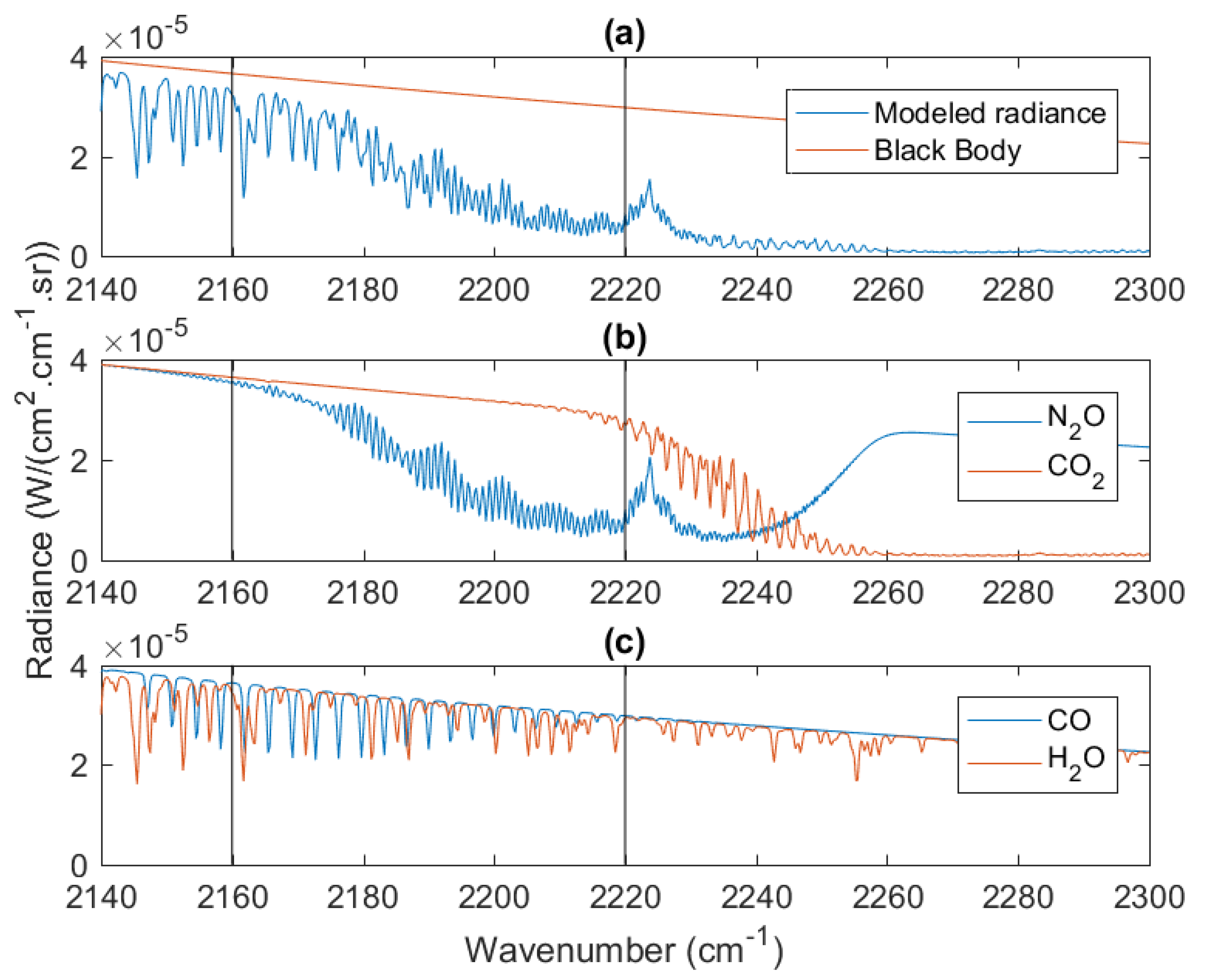
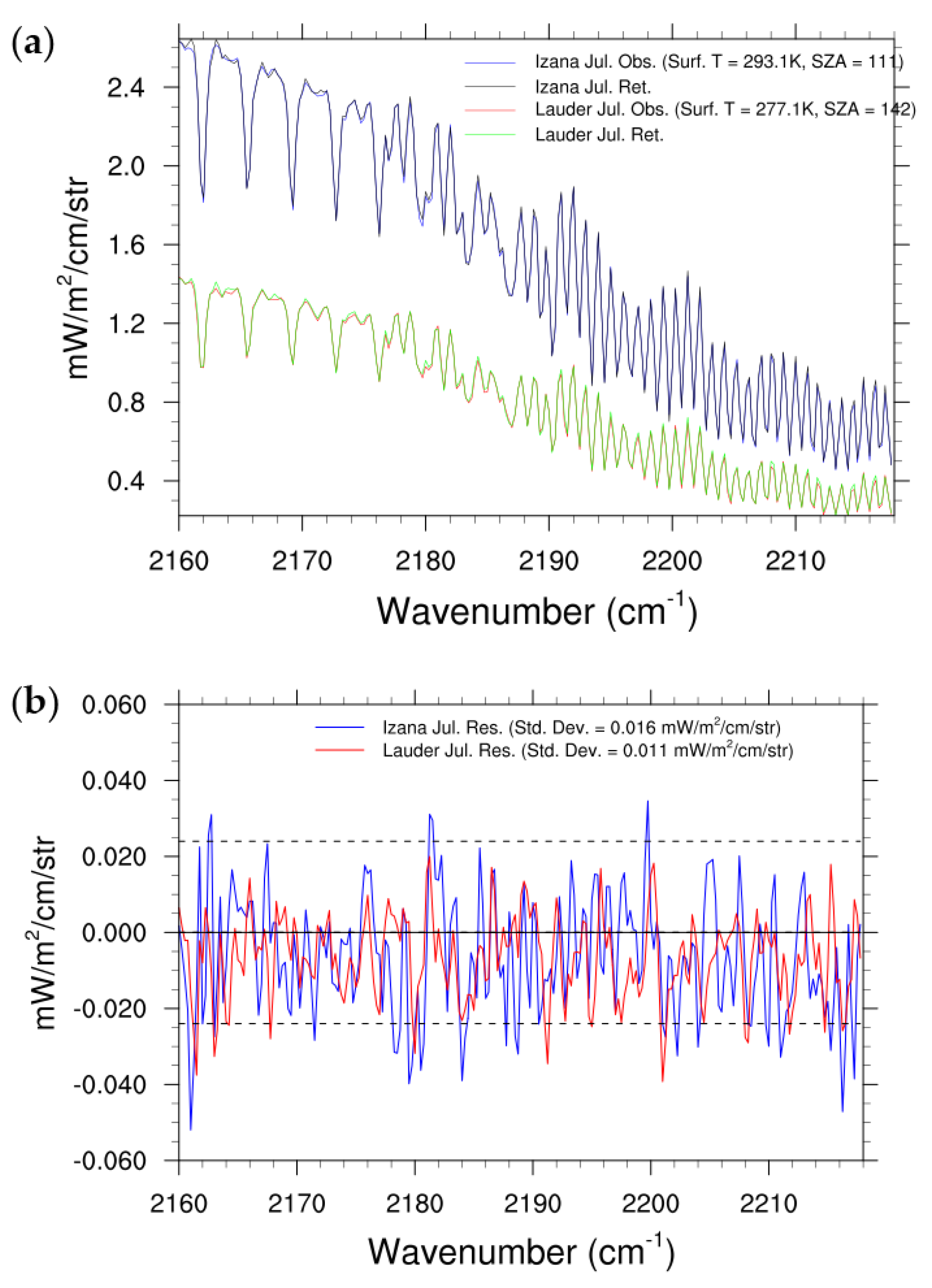

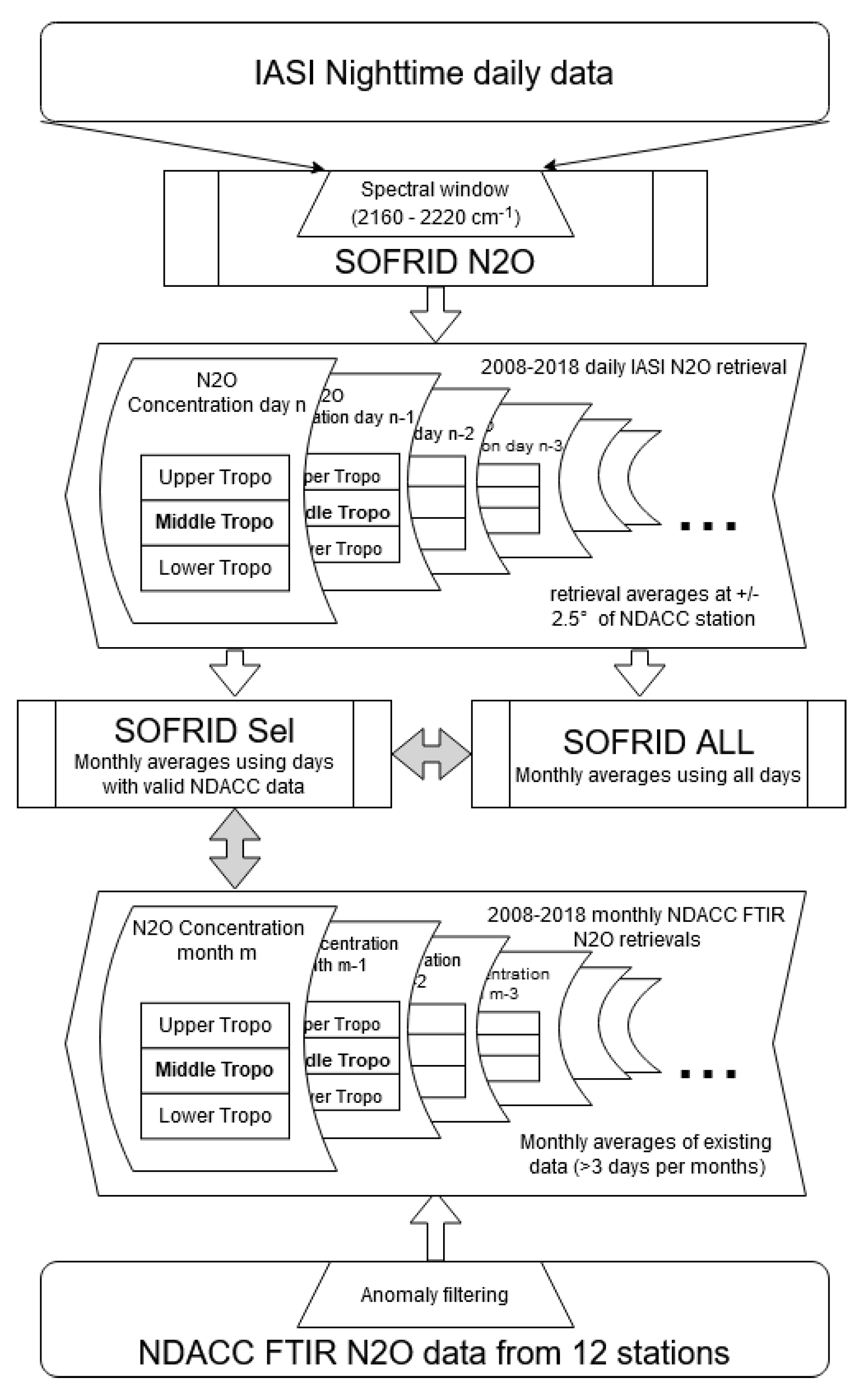
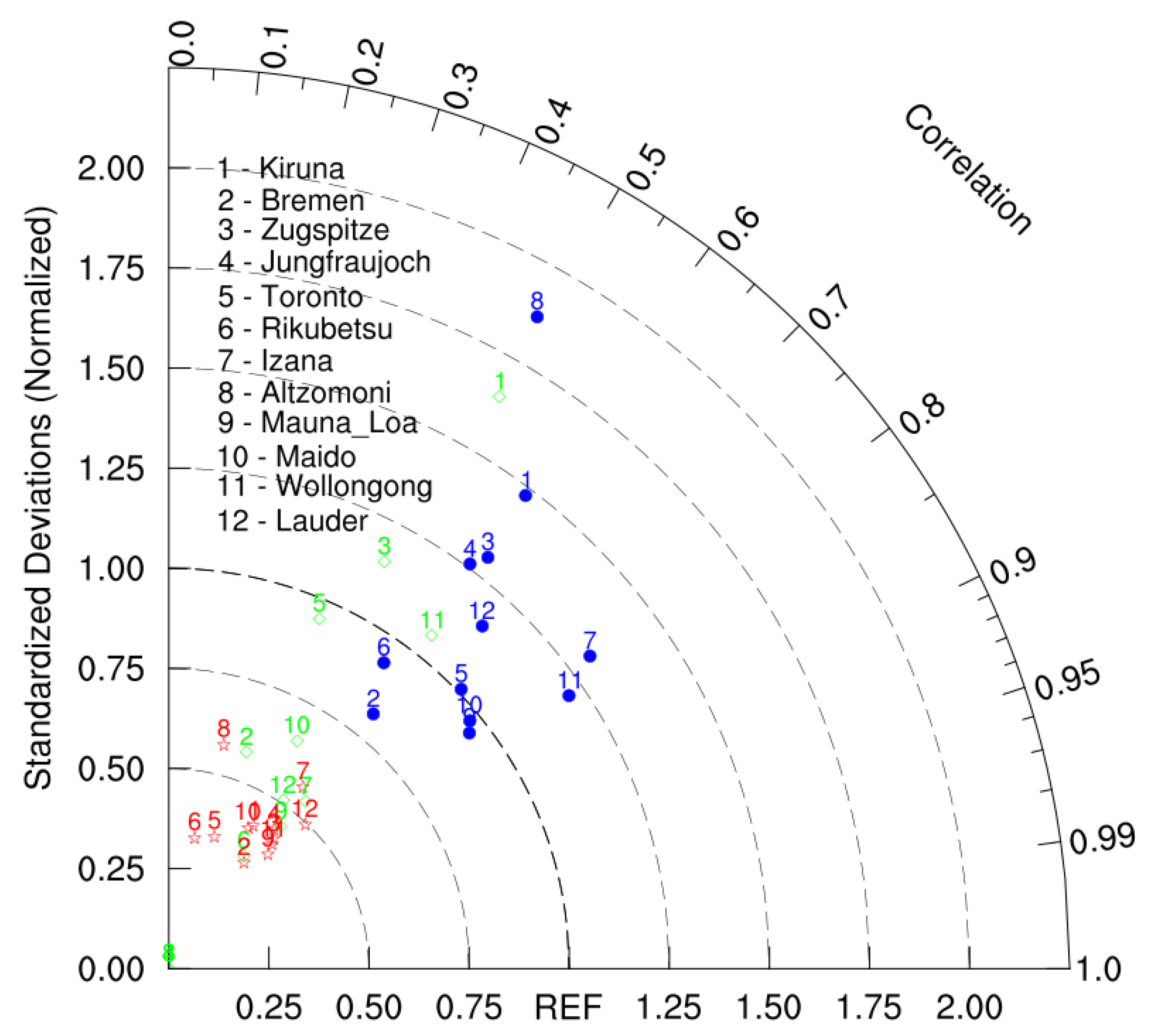
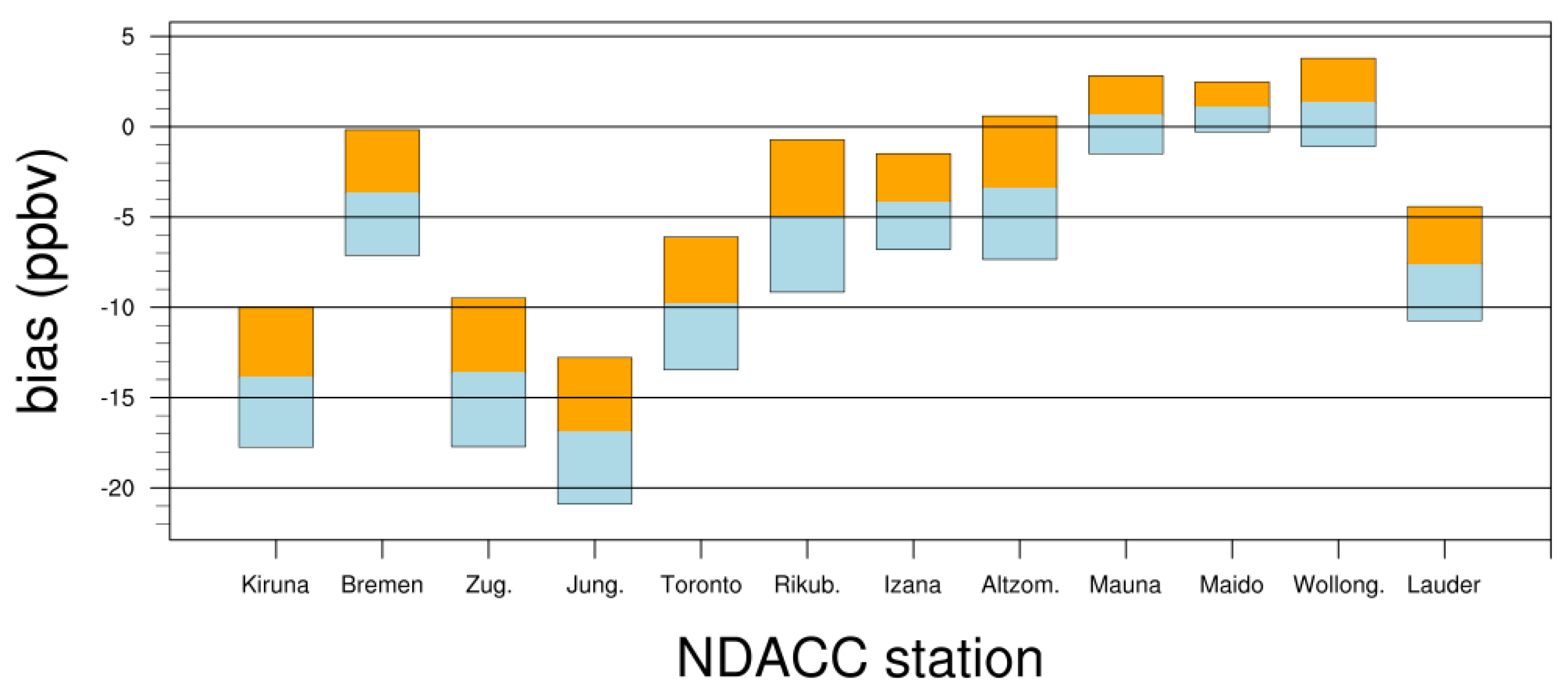


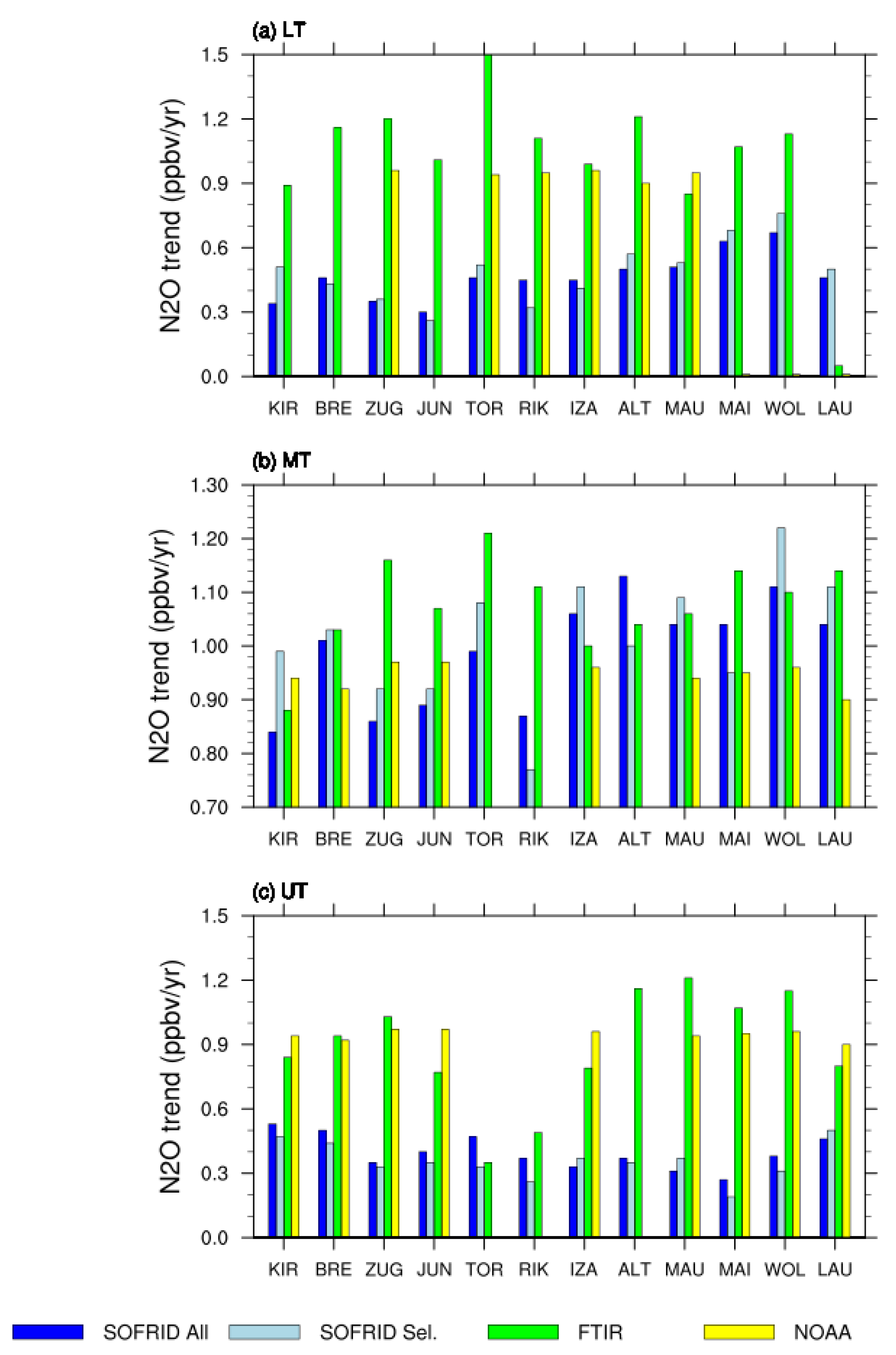
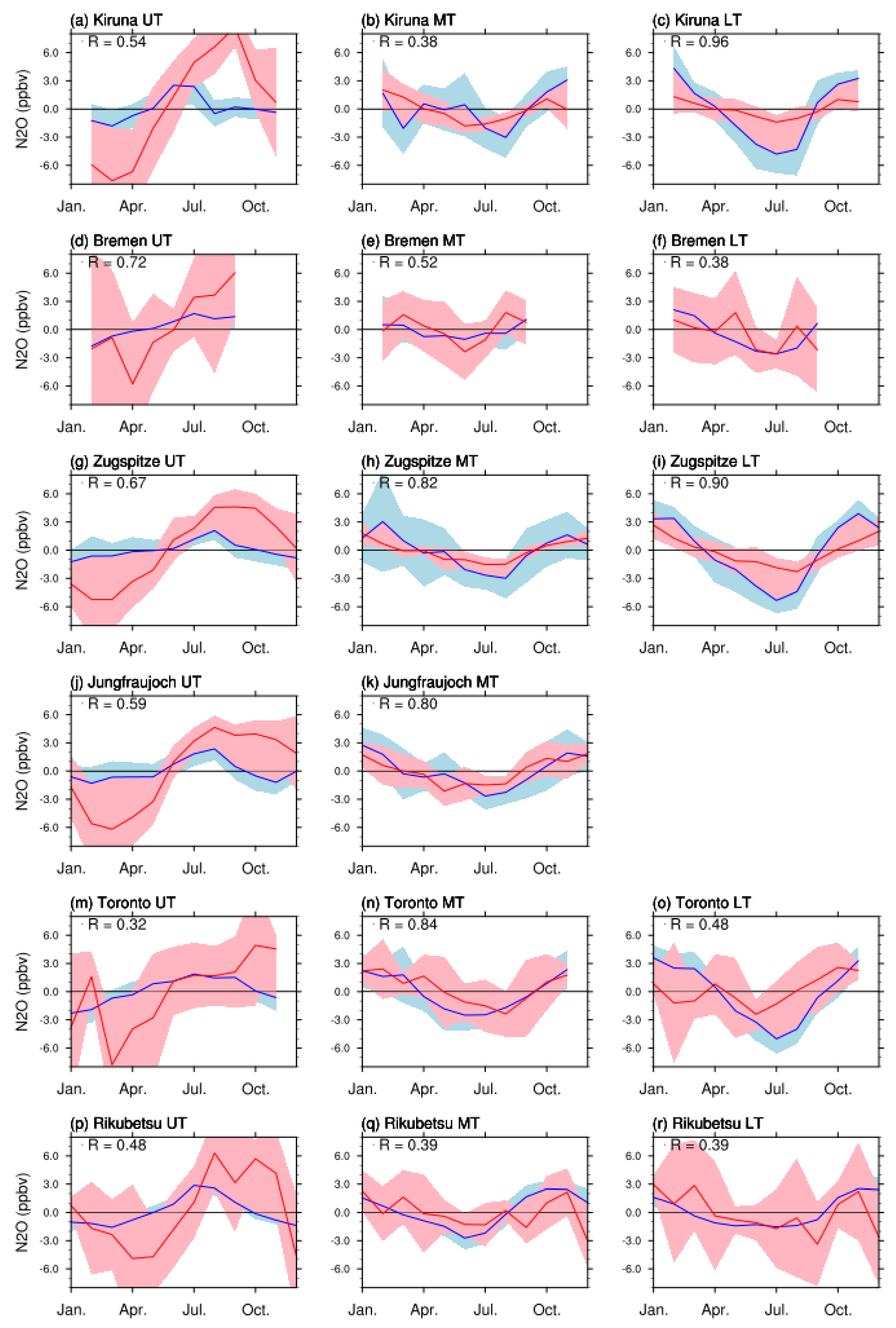
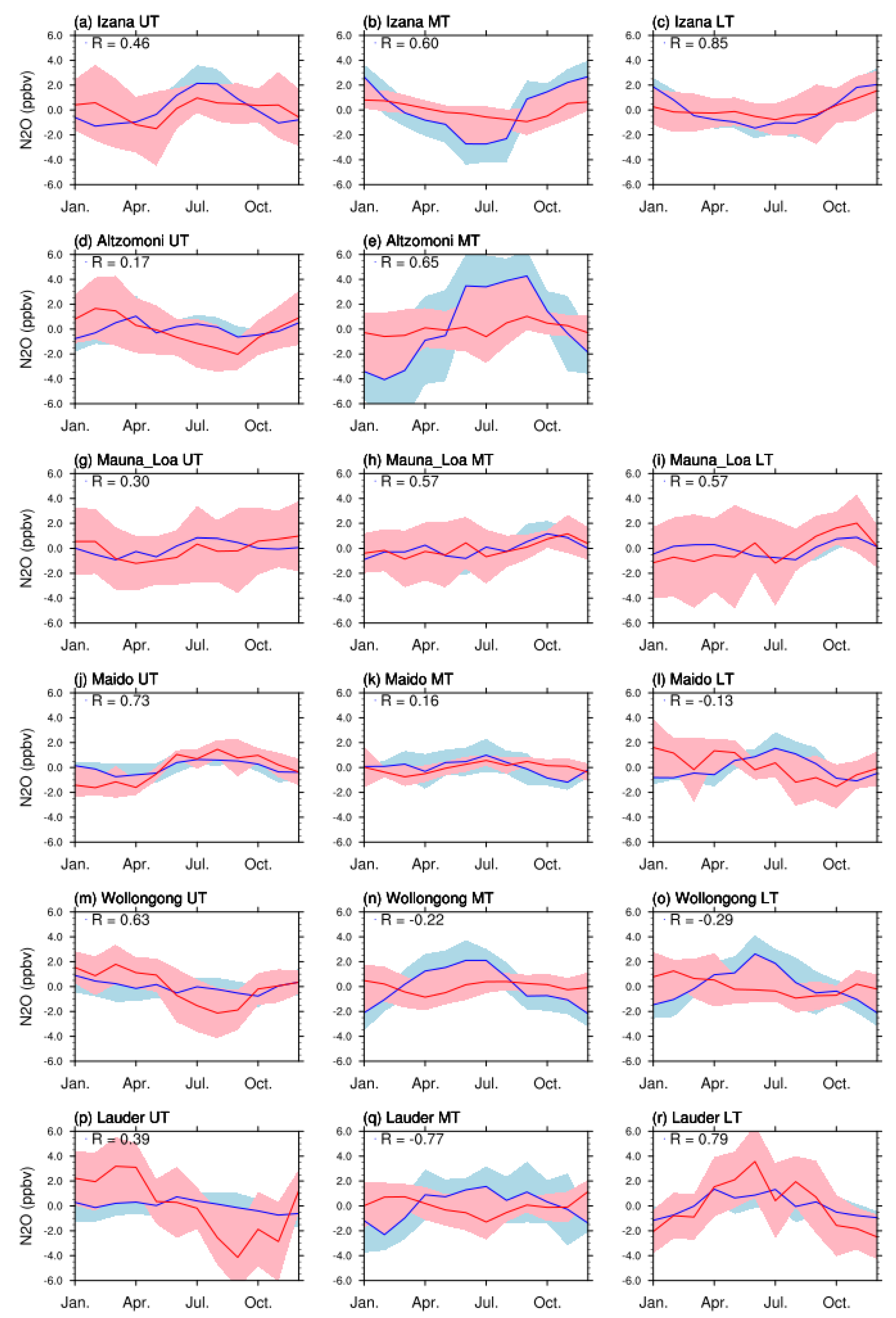
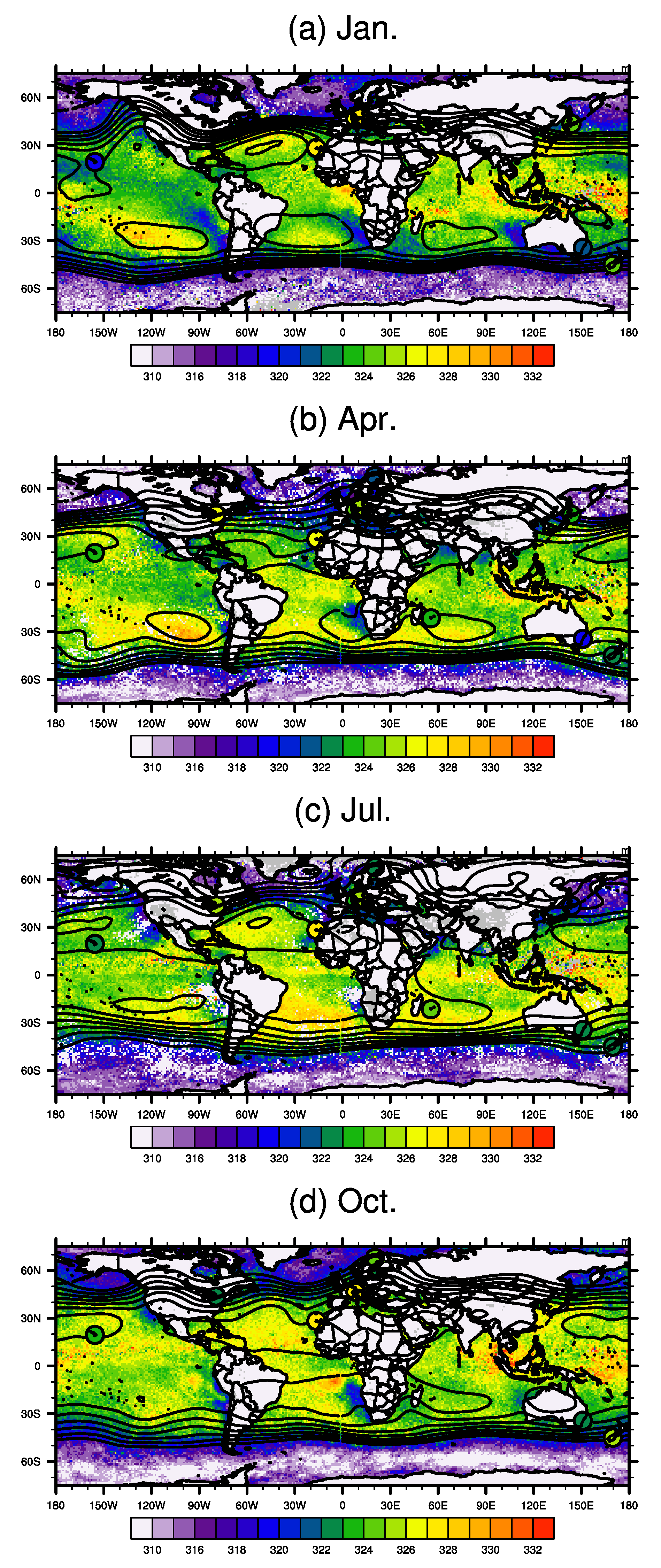
| Station | Latitude | Longitude | Altitude (m) | No Data | Months with Data |
|---|---|---|---|---|---|
| Kiruna | 67.84 | 20.40 | 43 | 96 | |
| Bremen | 53.10 | 8.85 | 46 | 51 | |
| Zugspitze | 47.42 | 10.98 | 2950 | 130 | |
| Jungfraujoch | 46.55 | 7.98 | 3580 | 126 | |
| Toronto | 43.66 | −79.40 | 174 | 89 | |
| Rikubetsu | 43.46 | 143.77 | 57 | 2011–2013 | 54 |
| Izana | 28.30 | −16.48 | 2370 | 117 | |
| Mauna-Loa | 19.54 | −155.57 | 3400 | 95 | |
| Altzomoni | 19.12 | 98.66 | 3985 | 2008–2012 | 64 |
| Maido | −21.5 | 55.4 | 2155 | 2008–2013 | 60 |
| Wollongong | −34.41 | 150.88 | 30 | 121 | |
| Lauder | −45.04 | 169.68 | 37 | 118 |
| Station | January | April | July | October |
|---|---|---|---|---|
| Izana LT | 0.5 (4.7) | 1.2 (4.4) | 0.8 (5.1) | 0.5 (4.8) |
| Izana MT | 1.1 (2.6) | 1.2 (2.4) | 1.2 (2.4) | 1.1 (2.5) |
| Izana UT | 0.8 (3.2) | 0.8 (3.1) | 0.9 (2.9) | 0.9 (2.6) |
| Wollongong LT | 0.8 (4.8) | 0.8 (4.5) | 0.7 (4.3) | 1.0 (4.8) |
| Wollongong MT | 1.1 (2.7) | 1.2 (2.6) | 1.1 (2.6) | 1.1 (2.7) |
| Wollongong UT | 0.8 (3.0) | 0.9 (3.1) | 0.7 (3.6) | 0.9 (2.9) |
| Station | January | April | July | October |
|---|---|---|---|---|
| Izana LT | 0.3 (6.1) | 0.3 (6.8) | 0.2 (7.5) | 0.3 (7.0) |
| Izana MT | 0.8 (2.1) | 0.8 (2.7) | 0.8 (2.9) | 0.8 (2.5) |
| Izana UT | 0.7 (2.8) | 0.6 (3.1) | 0.6 (3.2) | 0.7 (2.8) |
| Wollongong LT | 0.6 (3.5) | 0.6 (3.7) | 0.7 (3.9) | 0.7 (4.2) |
| Wollongong MT | 0.6 (2.0) | 0.7 (2.2) | 0.8 (3.2) | 0.8 (2.5) |
| Wollongong UT | 0.8 (2.9) | 0.8 (2.9) | 0.9 (4.3) | 0.9 (3.1) |
| Station | Bias (ppbv) | RMSD (ppbv) | R | RMS IASI | RMS FTIR |
|---|---|---|---|---|---|
| Kiruna | −13.9 | 3.9 | 0.60 | 4.8 | 3.3 |
| Bremen | −3.6 | 3.5 | 0.63 | 3.5 | 4.3 |
| Zugspitze | −13.6 | 4.1 | 0.61 | 5.1 | 3.9 |
| Jungfraujoch | −16.8 | 4.0 | 0.60 | 4.9 | 3.9 |
| Toronto | −9.2 | 3.4 | 0.72 | 4.6 | 4.6 |
| Rikubetsu | −4.9 | 4.2 | 0.57 | 4.4 | 4.7 |
| Izana | −4.1 | 2.6 | 0.80 | 4.4 | 3.4 |
| Altzomoni | −3.4 | 4.0 | 0.49 | 4.5 | 2.4 |
| Mauna-Loa | 0.7 | 2.2 | 0.79 | 3.2 | 3.4 |
| Maido | 1.1 | 1.4 | 0.77 | 2.0 | 2.1 |
| Wollongong | 1.3 | 2.4 | 0.83 | 4.3 | 3.6 |
| Wollongong Sea | 4.2 | 2.6 | 0.76 | 4.0 | 3.6 |
| Lauder | −7.6 | 3.2 | 0.68 | 4.1 | 3.6 |
| Lauder Sea | −2.3 | 2.8 | 0.74 | 4.1 | 3.6 |
| NOAA/ESRL Station | Latitude | Longitude | Elevation (m) | NDACC Station |
|---|---|---|---|---|
| Pallas-Salmantunturi | 67.97 | 24.11 | 565 | Kiruna |
| Ochsenkopf | 50.03 | 11.81 | 1022 | Bremen |
| Hoenpeissenberg | 47.80 | 11.02 | 936 | Jungfraujoch and Zugspitze |
| Izana | 28.31 | −16.50 | 2373 | Izana |
| Mauna-Loa | 19.53 | 155.58 | 3397 | Mauna-Loa |
| Mahe Island | −4.68 | 55.53 | 2 | Maido |
| Cape Grimm | −40.68 | 144.69 | 94 | Wollongong |
| Baring Head | −41.41 | 174.87 | 85 | Lauder |
| Station | SOFRID All Data | SOFRID Coincident Data | FTIR | NOAA/ESRL |
|---|---|---|---|---|
| Kiruna | 0.84 ± 0.08 | 0.99 ± 0.12 | 0.88 ± 0.06 | 0.94 ± 0.01 |
| Bremen | 1.01 ± 0.06 | 1.03 ± 0.12 | 1.03 ± 0.14 | 0.92 ± 0.01 |
| Zugspitze | 0.86 ± 0.09 | 0.92 ± 0.12 | 1.16 ± 0.04 | 0.97 ± 0.01 |
| Jungfraujoch | 0.89 ± 0.07 | 0.92 ± 0.11 | 1.07 ± 0.06 | 0.97 ± 0.01 |
| Toronto | 0.99 ± 0.07 | 1.08 ± 0.09 | 1.21 ± 0.12 | |
| Rikubetsu | 0.87 ± 0.07 | 0.77 ± 0.12 | 1.11 ± 0.12 | |
| Izana | 1.06 ± 0.06 | 1.11 ± 0.08 | 1.00 ± 0.03 | 0.96 ± 0.01 |
| Altzomoni | 1.13 ± 0.10 | 1.00 ± 0.29 | 1.04 ± 0.11 | |
| Mauna-Loa | 1.04 ± 0.03 | 1.09 ± 0.05 | 1.06 ± 0.07 | 0.94 ± 0.01 |
| Maido | 1.04 ± 0.03 | 0.95 ± 0.09 | 1.14 ± 0.06 | 0.95 ± 0.01 |
| Wollongong | 1.11 ± 0.05 | 1.22 ± 0.06 | 1.10 ± 0.03 | 0.96 ± 0.01 |
| Lauder | 1.04 ± 0.06 | 1.11 ± 0.08 | 1.14 ± 0.04 | 0.90 ± 0.01 |
| Average | 0.99 ± 0.10 | 1.01 ± 0.12 | 1.09 ± 0.11 | 0.95 ± 0.02 |
| 0.98 ± 0.10 | 1.05 ± 0.10 | 1.08 ± 0.10 |
Publisher’s Note: MDPI stays neutral with regard to jurisdictional claims in published maps and institutional affiliations. |
© 2021 by the authors. Licensee MDPI, Basel, Switzerland. This article is an open access article distributed under the terms and conditions of the Creative Commons Attribution (CC BY) license (http://creativecommons.org/licenses/by/4.0/).
Share and Cite
Barret, B.; Gouzenes, Y.; Le Flochmoen, E.; Ferrant, S. Retrieval of Metop-A/IASI N2O Profiles and Validation with NDACC FTIR Data. Atmosphere 2021, 12, 219. https://doi.org/10.3390/atmos12020219
Barret B, Gouzenes Y, Le Flochmoen E, Ferrant S. Retrieval of Metop-A/IASI N2O Profiles and Validation with NDACC FTIR Data. Atmosphere. 2021; 12(2):219. https://doi.org/10.3390/atmos12020219
Chicago/Turabian StyleBarret, Brice, Yvan Gouzenes, Eric Le Flochmoen, and Sylvain Ferrant. 2021. "Retrieval of Metop-A/IASI N2O Profiles and Validation with NDACC FTIR Data" Atmosphere 12, no. 2: 219. https://doi.org/10.3390/atmos12020219
APA StyleBarret, B., Gouzenes, Y., Le Flochmoen, E., & Ferrant, S. (2021). Retrieval of Metop-A/IASI N2O Profiles and Validation with NDACC FTIR Data. Atmosphere, 12(2), 219. https://doi.org/10.3390/atmos12020219






